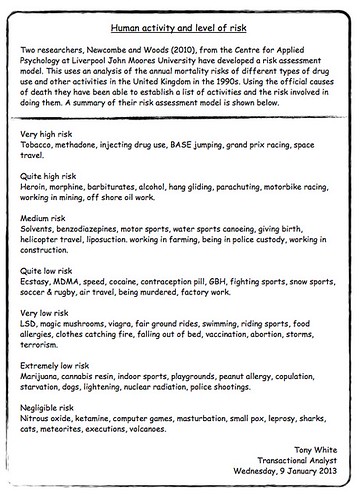With the concept of passive suicidality one logically comes to define a different group of suicidal individuals. Most often suicidal people are seen to be despairing and desperate people who are enduring a great deal of suffering and pain. This group does exist and much has been said about them by a great many people.
Here is part of a model of human activity and level of risk. As one can see grand prix racing is one of the most highly dangerous activities one can engage in.
Those people who are such racing car drivers engage in this very high risk activity voluntarily, repetitively and over long periods of time. What does this say about those individuals? This must make some kind of statement about their psyche?
If someone engages in a piece of behaviour because they are pressured by others, or for a short period of time and then stops, or does it only occasionally then that says little about who they are and their psychology. But if someone does a piece of behaviour voluntarily, repeatedly and over an extended period of time then that says a lot about who they are and their internal psychological motivations. Humans will not do such ongoing repetitive behaviour unless it contributes to who they are and their life script. They simply wont do it for any length of time.
Such racing car drivers are knowingly and repeatedly putting them selves in a position where they know it may kill them. They are repeatedly placing self in a position where the risk of death is significantly increased. This speaks loudly about who they are and their internal psychological motivations and one could argue that this is suicidal behaviour. These people could be seen to be behaving in a suicidal way.
At the same time many of these people one could assume are reasonably well adjusted and certainly not like the usual suicidal person described above who is despairing and in a great deal of pain. Thus we are led to a position where one needs to reformulate the understanding of the suicidal person and indeed the concept of suicidality.
There is a group, indeed a significant sized group of people who engage in such suicidal behavior who are well adjusted and not suffering any significant depression, pain or angst. Suicidal behaviour is not solely restricted to the neurotic and maladjusted. It also resides in quite a sizable group of people who would generally be seen as psychologically well adjusted. Suicidality and normal psychological adjustment can exist in one individual at one time.
Two high profile Australian examples are Peter Brock and Steve Irwin. These two men died whilst engaging in high risk pursuits which they had been doing for many years. Indeed the high risk behaviour had become their occupations. Peter Brock died in a car accident whilst racing and Steve Irwin was making a film whilst swimming with sting rays. He died when he got to close to a sting ray and it shot its venomous 8 inch barb into him.
In this sense we have identified a new clinical group with quite different features from what is usually seen as the clinical status of the suicidal person. It is unusual because suicidality is generally considered quite an abnormal psychological state or it is seen to involve a significant level of maladjustment. However we have now identified a group who overall are generally well adjusted but still behave in an active suicidal way.
This amounts to an odd psychological situation. It is rare to find a person who is generally well adjusted but also has a specific piece of significant psychological abnormality. For instance most people whilst being suicidal also may have a mental illness, be a substance abuser, be depressed, have been in prison, be socially isolated and so forth. This is the usual clinical situation of the suicidal person.
We have now identified another group who do not fit this usual psychological profile. They repeatedly display suicidal behaviour but otherwise do not display any psychological abnormality.
Graffiti



This is an interesting post - the topic relates indirectly to my research. Behavior is influenced more by perceived risk as compared to actual (statistical) risk. Perceived risk can change day to day depending on events and conditions one is aware of. When risk becomes normal, people become more carefree about hazards they are exposed to. Normalized risk is a huge factor contributing to accidents on the job.
ReplyDeleteHi Tony, I enjoyed reading your post (as usual!).
ReplyDeleteThere was one sentence I found especially thought-provoking; "suicidality is generally considered quite an abnormal psychological state or it is seen to involve a significant level of maladjustment".
I got to thinking about some of the people I see in palliative care. Patients with a terminal or degenerative illness often say to me "I'd just like it to be over" - and of course in Europe there is an ongoing debate about the 'right to die'. One of the difficulties is telling the difference between depression and disease symptoms.... and of course, then there's the question I'd like to hear your thoughts on - is it possible that a wish to end one's life can be non-scripty (i.e not a pathological or maladjusted state)?
Thanks for your comment Ian,
ReplyDeleteAnd I think you make a good point and provide an exception to my statement about the abnormality of suicide. I would agree with your suggestion that the type of suicide you describe would not be scripty. Perhaps I could defend my position by arguing that what you propose is not a suicide but could be more aptly renamed self induced euthanasia. Thanks again for your ideas. Tony